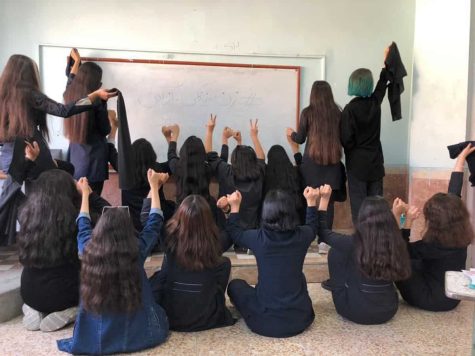Bridge Breaking
Numbers were shouted out like bids at an auction. Students gathered, many sitting, too nervous to stand. Junior Samantha Steinberg bit her lip and clasped her hands together at her chest, wincing periodically as the sound of small cracks would shoot into the air.
“Twenty!” physics teacher George Stimson called, and as though on cue, the intricate structure nearly exploded into factures, succumbing at last as she cheered for its performance.
Applause sounded from around the table, and within moments the next bridge was brought forward to face fate.
Finalists in George Stimson’s physics class competed last Wednesday, Jan. 16, for the title of bridge-building champion. Some three-dozen creations were put to the test, and while many kids felt twinges of sadness in their work’s destruction, others couldn’t help but revel in the class assignment.
Assigned the project before winter break, they had only flexible wooden strips and glue as their construction materials. The structural requirements were all but nonexistent, save for a minimum weight limit of 3 pounds and the necessity of a one-inch platform for the weighing apparatus.
This apparatus resembled a metal beam with strings on either side, holding up a large bucket that water continuously streamed into. In order to qualify for the final show-down, one’s bridge had to support 18 pounds worth.
The time invested by the finalists ranged anywhere from two hours to all of winter break, and the products of such commitment each proved very different in design.
Junior Marco Rivera estimated a total of 14 hours devoted to the process:
“I wanted my design to resemble a triangle and I kind of just built it up from there.” However, upon assembly, he realized “complexity did not always mean strength,” and made changes to his blueprint. This simpler final product wound up holding 30 pounds.
While many bridges shared this triangle-like characteristic, others more closely resembled arcs. Junior Sarah Hyndman brought in geometry to reason the benefits of a partial dodecahedron, while junior Hanna Kobayashi received inspiration from the shape of the Golden Gate Bridge. Hyndman’s docked in at 26 pounds, and Kobayashi’s at 20.
Not everyone had such an originally established approach, though. Junior Brett Wilson explained, “My thought process was ‘We are just going to go with it. Oh goodness, I really hope that this works…’” Nevertheless, her bridge lasted up until the 30-pound mark.
One of the most surprised students was junior Jaquelyn Teza, who similarly “just sort of went for it.” Taking the triangle approach only because those were the majority of the examples in class, she came in second place, her bridge holding 52 pounds. “I didn’t even think it would hold the weighing apparatus, but I was pleasantly surprised by the turn out!” she said.
In first, beating Teza by a measure of two pounds, was junior Tomas Sandoval, whose bridge only caved after having to carry 54 pounds of water. As the overall winner, he received a remote controlled helicopter, in addition to bragging rights of course.
When looking back to the project as a whole, students expressed a multitude of feelings. Wilson said she found difficulty early on. “I didn’t like how time consuming it was [and] had no idea how to make a bridge in the first place,” she said. “That was an issue.”
The premise of patience was a challenge faced by builders across the board.
Junior Robert Stegman, whose bridge held 23 pounds, admitted the building process was “pretty boring,” and Rivera found it especially “frustrating” at times.
One primary source of this frustration came from dealing with the glue. Said Teza, “It took forever because it would never stick! It would just slide right off the bridge, which made it difficult.”
Despite these hardships, the project offered a fair share of positive experiences as well.
“It really ended up showing who put effort into it and who didn’t, and it allowed us to be creative and work with our hands more,” said junior Johnny Menhennet.
Wilson also appreciated the project’s “openness,” and Teza liked that is was “a really unique project” that “took a lot of thought.” Steinberg said her favorite part came just from seeing everyone else’s bridges the day they were all brought in.
When it came time to literally push every bridge past its breaking point, there also were reactions from every part of the spectrum.
“To be honest, it was difficult,” said junior Olivia Nyugen, whose bridge finally crumbled at 23 pounds. “I never had a project I worked so hard on and see being destroyed.”
“It’s like a child,” said Steinberg. “You put so much time into it and are so careful around it. When it just breaks, all your hard work tumbles to the floor.”
Others saw their bridge’s fracturing as something bittersweet.
“In class, it was very hard to see it, but after I made it to finals I had no qualms,” said Menhennet. “It was sort of validating to see it break at the weight it did.”
Kobayashi agreed. “It was definitely more exciting to challenge it.”
Further on this side of the spectrum were those that favored the ending demolition more than anything.
“I had no desire to keep it, and for some reason I really wanted to see it split in half,” said Teza.
“Oddly, seeing it break was a very satisfying experience,” Wilson said. “It was time for the pain it gave me to be reciprocated.”
Rivera reasoned, “All our other school work meets the same fate in the end, doesn’t it? I see this bridge no differently.”
Ultimately, despite the varying emotions, Hydman put it into perspective, saying, “It was sad, but it means that all the work amounted to something and was seen through. At least I actually learned how to create a stable structure.”









